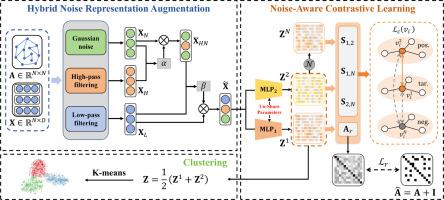基于三重智能对比学习的双水平噪声增强图聚类
IF 7.6
1区 计算机科学
Q1 COMPUTER SCIENCE, ARTIFICIAL INTELLIGENCE
引用次数: 0
摘要
对比深度图聚类由于其自监督表示学习机制和优异的聚类性能而受到广泛关注。虽然现有的方法大多依靠低通滤波来实现去噪,但忽略了高频信息和噪声在获得全面和鲁棒表示方面的潜在优势。其次,常用的对比学习策略一般将非目标样本视为负样本,容易引发对比偏差,削弱表征质量。为此,本文提出了一种新的对比图聚类框架——双水平噪声增强图聚类与三元对比学习(DNA-CGC),增强噪声的优势,丰富表征学习,放大对比学习效果。它包括两个核心模块:混合噪声表示增强(HNRA)和噪声感知对比学习(NACL)。HNRA模块将低频和高频图信号集成在一起,捕获共享和独特的节点特征,同时引入高斯噪声作为有益的扰动,丰富表示多样性,从而实现混合噪声下的多信息融合。另一方面,NACL模块通过高斯噪声产生排他的负样本,并构建三联体对比对(Target, Positive, negative),通过防止假阴性来减轻对比偏差,进一步促进更准确的语义对齐。在六个基准数据集上的大量实验验证了DNA-CGC在聚类性能和表示质量方面的显著优势。代码可以在https://github.com/TianxiangZhao0474/DNA-CGC.git上获得。本文章由计算机程序翻译,如有差异,请以英文原文为准。

Dual-level noise augmentation for graph clustering with triplet-wise contrastive learning
Contrastive deep graph clustering has attracted widespread attention due to its self-supervised representation learning mechanism and excellent clustering performance. Although, most existing methods rely on low-pass filtering to achieve denoising, ignoring the potential benefit of high-frequency information and noise in obtaining comprehensive and robust representation. Second, commonly used contrastive learning strategies generally treat non-target samples as negative samples, which is prone to triggering contrastive bias and weakening the representation quality. To this end, this paper proposes a novel contrastive graph clustering framework, Dual-level Noise Augmentation for Graph Clustering with triplet-wise Contrastive learning (DNA-CGC), strengthening the benefit of noise to enrich the representation learning and amplify the contrastive learning efficacy. It consists of two core modules, Hybrid Noise Representation Augmentation (HNRA) and Noise-Aware Contrastive Learning (NACL). The HNRA module integrates low- and high-frequency graph signals to capture both shared and distinctive node characteristics, while introducing Gaussian noise as beneficial perturbation to enrich the representation diversity, thereby achieving multi-information fusion under hybrid noise. The NACL module, on the other hand, generates exclusive negative samples through Gaussian noise and constructs the triplet-wise contrastive pairs (Target, Positive, Negative), mitigating the contrastive bias by preventing false negatives and further facilitating more accurate semantic alignment. Extensive experiments on six benchmark datasets validate the significant advantages of DNA-CGC in terms of clustering performance and representation quality. The code could be available at https://github.com/TianxiangZhao0474/DNA-CGC.git.
求助全文
通过发布文献求助,成功后即可免费获取论文全文。
去求助
来源期刊

Pattern Recognition
工程技术-工程:电子与电气
CiteScore
14.40
自引率
16.20%
发文量
683
审稿时长
5.6 months
期刊介绍:
The field of Pattern Recognition is both mature and rapidly evolving, playing a crucial role in various related fields such as computer vision, image processing, text analysis, and neural networks. It closely intersects with machine learning and is being applied in emerging areas like biometrics, bioinformatics, multimedia data analysis, and data science. The journal Pattern Recognition, established half a century ago during the early days of computer science, has since grown significantly in scope and influence.
 求助内容:
求助内容: 应助结果提醒方式:
应助结果提醒方式:


